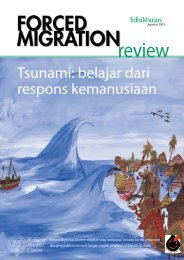FMR 42 full issue pdf - Forced Migration Review
FMR 42 full issue pdf - Forced Migration Review
FMR 42 full issue pdf - Forced Migration Review
You also want an ePaper? Increase the reach of your titles
YUMPU automatically turns print PDFs into web optimized ePapers that Google loves.
<strong>FMR</strong> <strong>42</strong><br />
Sexual orientation and gender identity and the protection of forced migrants 61<br />
Grantmaking for SOGI programmes<br />
Andrew S Park<br />
With <strong>issue</strong>s relating to sexual orientation and gender identity a relatively new field for funders,<br />
the opportunity exists for funders to exert strategic influence on the development of improved<br />
policy and practice.<br />
The availability and limitations of funding<br />
can heavily influence response to forced<br />
migration. Because <strong>issue</strong>s of sexual orientation<br />
and gender identity (SOGI) are relatively new<br />
to many state and NGO actors in this field,<br />
and because current economic pressures<br />
are forcing some tough choices at all levels,<br />
current funding patterns are playing a<br />
decisive role in the development of this <strong>issue</strong>.<br />
The term ‘funder’ needs definition for the<br />
purposes of this discussion. Indeed, the<br />
practice of many in this and other fields is<br />
to group all sources of funding under the<br />
category of ‘donor’, thereby sidestepping<br />
the various restrictions and opportunities<br />
associated with each type of funding:<br />
Public: controlled by government officials and<br />
arising out of the budgets of governmental<br />
and intergovernmental agencies. This includes<br />
bilateral development and international<br />
cooperation funds as well as UN funding.<br />
Public funding is often driven by foreign<br />
policy priorities and commitments of states.<br />
Private: includes funding from foundations,<br />
both public and private (which leads to some<br />
confusion). Roughly speaking, a private<br />
foundation receives funds from one or a<br />
small number of sources for the purposes<br />
of supporting charitable activities. Funds<br />
disbursed by the private foundation come<br />
from its assets. Public foundations receive<br />
ongoing support from the public, or at least<br />
a larger number of sources. Often they must<br />
engage in constant fundraising in order<br />
to maintain their giving programmes. A<br />
public foundation is essentially the same<br />
as an NGO; the difference is that public<br />
foundations accomplish their mission – and<br />
can influence policy – by raising money and<br />
making grants while NGOs accomplish their<br />
mission by raising money and conducting<br />
advocacy, providing services, etc. The absence<br />
of cumbersome government administration<br />
allows some private funders to be more<br />
flexible and innovative in their grantmaking.<br />
Sources and streams of funding<br />
The latest and most comprehensive report<br />
tracking all international SOGI grantmaking<br />
identified a total of US$35.5 million provided<br />
in 2010 by 64 institutions to organisations<br />
and projects in 94 countries working<br />
internationally or in the global South and<br />
East. This included public and private<br />
funding. Most dollars came from private<br />
funders. Although Sweden, the Netherlands<br />
and Norway all ranked amongst the top<br />
seven donor countries, the total of all<br />
public funding constituted was only 36%<br />
of the $35.5m; the median grant size was<br />
$15,000 and 91% were one-time awards.<br />
Very little of this funding goes to forced<br />
migration <strong>issue</strong>s. Half of all funds addressed<br />
human rights in a broad sense. Only<br />
$601,550 were designated as addressing<br />
the <strong>issue</strong> of ‘Immigrant/Migrant Rights’<br />
(including refugees and asylum seekers),<br />
representing 5.5% of the grant funds.<br />
Equally informative is the question of which<br />
entities are making grants. The report<br />
identified the top grantmakers according to<br />
the total amount of dollars for SOGI <strong>issue</strong>s.<br />
A comparison of that list with lists of major<br />
funders in the field of forced migration<br />
reveals little intersection. 1 Only a handful<br />
of foundations with the largest assets fund<br />
actively in both fields. If one looks at LGBT<br />
funders with the highest number of LGBT<br />
grants, as opposed to the largest amount of<br />
dollars, the overlap between the two funding<br />
communities is almost non-existent.




